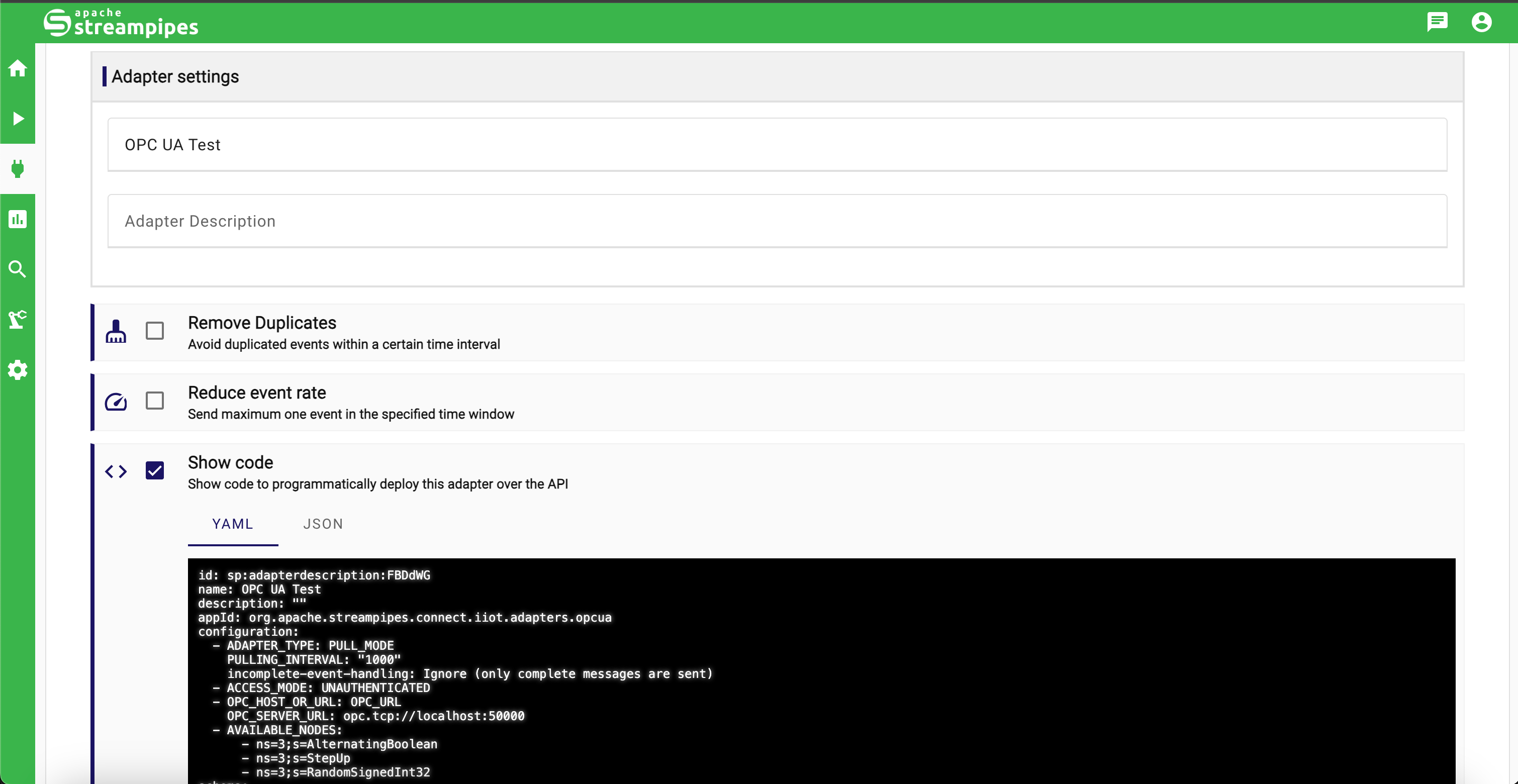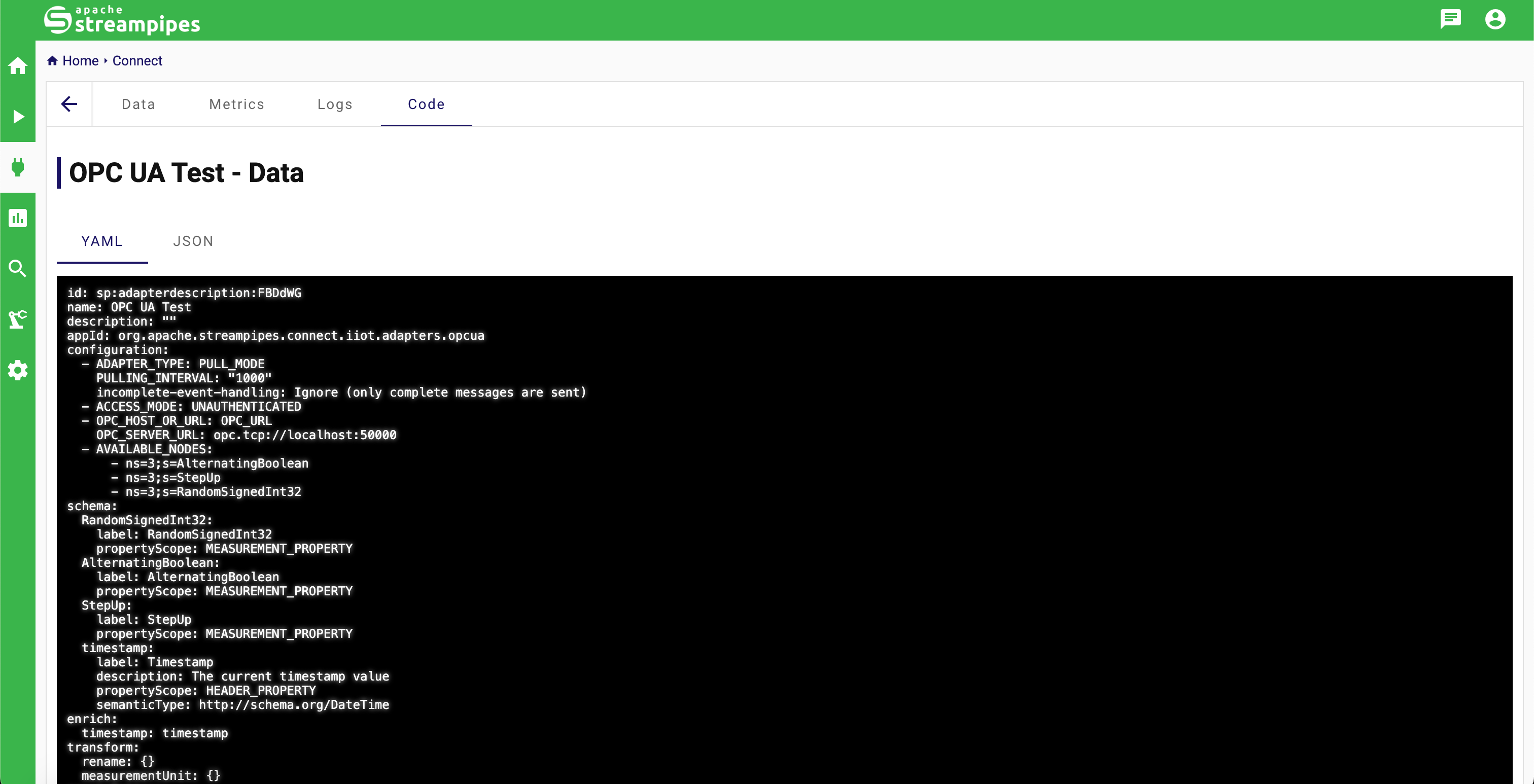Adapters as Code
In Apache StreamPipes, adapters are typically created via the web interface. However, it is possible to create adapters programmatically using a compact YAML format and the StreamPipes REST API. Programmatic creation of adapters can be a useful feature in cases where many similar adapters have to be created. In this case, an externally managed YAMl file containing the full adapter configuration can be used and modified.
Introduction
In StreamPipes, adapters are responsible for collecting data from various industrial data sources. While the UI simplifies this process, you can also manage adapters programmatically for better automation, integration with CI/CD pipelines, or infrastructure-as-code practices.
This guide demonstrates how to define and create adapters using a YAML format and StreamPipes REST API, offering more flexibility to manage adapters programmatically.
Adapter YAML Structure
An adapter in StreamPipes can be defined using a YAML file, which contains a compact description of the adapter configuration. The basic structure of the YAML format for an adapter definition includes:
- Name: The name of the adapter.
- ID: A unique ID for the adapter
- Description: An additional description of the adapter
- AppID: The adapter type
- Configuration: Configuration details such as connection details, polling intervals, data format, and more
- Schema: Schema refinements, e.g., additional label, description, semantic type and property scope
- Enrich: Enrichment rules. Currently, only timestamp enrichment rules are supported in the YAML specification
- Transform: Transformation rules. Currently, rename and measurement unit transforms are supported.
- CreateOptions: Additional operations that are executed upon adapter generation.
Here’s a sample structure to define an OPC-UA adapter:
name: My OPC Adapter
id: testadapter
description: Test
appId: org.apache.streampipes.connect.iiot.adapters.opcua
configuration:
- opc_host_or_url: OPC_URL
opc_server_url: opc.tcp://localhost:62541/milo
- adapter_type: PULL_MODE
pulling_interval: 1000
- access_mode: UNAUTHENTICATED
- available_nodes:
- "ns=2;s=Leakage Test Station/temperature"
- "ns=2;s=Leakage Test Station/pressure"
schema:
temperature:
propertyScope: measurement
label: Temp
description: Temperature value
semanticType: http://schema.org/temperature
enrich:
timestamp: timestamp
transform:
rename:
pressure: pressure3
createOptions:
persist: true
start: true
Programmatically creating adapters
Here is a walkthrough to create an adapter programmatically over the API:
Background: Internal adapter generation process
The YAML definition file is a more compact notation of StreamPipes internal data format to represent an adapter.
When creating an adapter over the user interface, StreamPipes requires some basic, adapter-specific settings.
Afterwards, a Guess Schema step is executed. In this step, StreamPipes connects to the underlying data sources, receives some samples of live data, determines the exact schema of the data stream and provides user with the source schema.
This schema can be further refined using Transformation Rules.
When an adapter is created using the more compact YAML notation, the same process is applied. Based on the provided configuration, the API connects to the given data source and determines the schema. The transformation rules provided in the YAMl definition are then applied on the original schema. Therefore, it is important that the provided schema refinement and transformation steps fit the original schema.
Getting a valid definition file
The easiest way to create a valid YAML file is the user interface. Within the StreamPipes Connect view, it is possible to export the YAML definition for all existing adapters.
In addition, the adapter generation wizard also offers the option to view the adapter configuration before creating the adapter by clicking the Code checkbox:

Another option is to open the adapter details view:

You can copy this definition and modify it according to your needs.
Configuration
For each configuration option in the user interface, there is a mapping to the YAMl definition.
A configuration value is a key/value pair, where the key corresponds to the internal name of the configuration and the value depends on the configuration type.
Schema
Schema definitions enhance the metadata of each field from the input stream. The following configurations are supported:
labelto add an additional (human-readable) label to the fielddescriptionfor an additional descriptionpropertyScopeto determine the type of the field (HEADER_PROPERTY, DIMENSION_PROPERTY or MEASUREMENT_PROPERTY)semanticTypeto provide the semantic type of the field (e.g.,https://schema.org/temperature)
Enrich
timestampdefines that an additional field named timestamp is added to each incoming event containing the ingestion time as a UNIX timestamp.
Transform
Currently, the following transforms are supported:
renamedefines renaming of individual fields from the input stream. A valid configuration consists of a key/value pair, where the key indicates the original field name and the value the target field name.measurementUnitdefines a value transformation between measurement units. A valid configuration consists of a key/value pair, where the key indicates the field name and the value the target measurement unit.
CreateOptions
Currently, two settings can be provided in the CreateOptions section:
persistindicates whether the data stream produced by the adapter should also be stored. In this case, aPersist Pipelineis automatically created.startindicates whether the adapter should be immediately started after creation.
API
To create a new adapter, call the StreamPipes API as follows:
POST /streampipes-backend/api/v2/connect/compact-adapters
Content-type: application/yml
Accept: application/yml
You must provide valid credentials by either adding a Bearer token or an API key:
X-API-USER: your username
X-API-KEY: your api key
The body of the request should contain the YAML definition.
It is also possible to provide the adapter specification as a JSON document. In this case, change the Content-type to application/json.